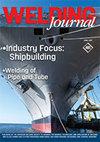Stress Distribution of EH40 with Defects Considering Solid-State Phase Transformation
IF 1.4
3区 材料科学
Q2 METALLURGY & METALLURGICAL ENGINEERING
引用次数: 0
Abstract
Residual stress of laser-welded marine steel EH40 was experimentally and numerically analyzed considering weld defects (collapse, hump, and unfitness) and solid-state phase transformation (SSPT). A double-cylindrical source model was used to simulate the temperature distribution. The mean prediction errors of the model without and with weld defects along the plate thickness were 9.2 and 3.5%. Based on the thermodynamics of SSPT, microstructure fractions were computed and verified by weld hardness test results. Under the effect of SSPT, residual stress changed from compressive stress to tensile stress with the increase of the distance from the weld center. Weld defects have an influence on the value of residual stress, and this effect was greater when SSPT was considered. The affected zone extended from the vicinity of weld defects to the whole weld. The variations of longitudinal residual stress (LRS) and transverse residual stress (TRS) caused by weld defects and SSPT both exceeded 150 MPa. LRS was mainly affected by the loss and increase of metal, while TRS was affected by the stress concentration caused by shape geometry changes. Thus, the influence of weld defects on TRS was greater than that on LRS. The proposed finite element model considering weld defects and SSPT can be used to accurately predict residual stress in laser welding of marine steel EH40 and provide a theoretical basis to reduce welding stress.考虑固态相变的有缺陷 EH40 的应力分布
考虑到焊接缺陷(塌陷、驼峰和不合格)和固态相变(SSPT),对激光焊接船用钢 EH40 的残余应力进行了实验和数值分析。采用双圆柱源模型模拟温度分布。沿板厚方向无焊接缺陷和有焊接缺陷模型的平均预测误差分别为 9.2% 和 3.5%。根据 SSPT 的热力学,计算了微观结构分数,并通过焊接硬度测试结果进行了验证。在 SSPT 作用下,残余应力随焊接中心距离的增加而从压应力变为拉应力。焊接缺陷对残余应力值有影响,当考虑到 SSPT 时,这种影响更大。受影响区域从焊接缺陷附近扩展到整个焊缝。由焊接缺陷和 SSPT 引起的纵向残余应力 (LRS) 和横向残余应力 (TRS) 的变化均超过 150 兆帕。纵向残余应力主要受金属损失和增加的影响,而横向残余应力则受形状几何变化引起的应力集中的影响。因此,焊接缺陷对 TRS 的影响大于对 LRS 的影响。所提出的考虑焊接缺陷和 SSPT 的有限元模型可用于准确预测船用钢 EH40 激光焊接中的残余应力,并为降低焊接应力提供理论依据。
本文章由计算机程序翻译,如有差异,请以英文原文为准。
求助全文
约1分钟内获得全文
求助全文
来源期刊

Welding Journal
工程技术-冶金工程
CiteScore
3.00
自引率
0.00%
发文量
23
审稿时长
3 months
期刊介绍:
The Welding Journal has been published continually since 1922 — an unmatched link to all issues and advancements concerning metal fabrication and construction.
Each month the Welding Journal delivers news of the welding and metal fabricating industry. Stay informed on the latest products, trends, technology and events via in-depth articles, full-color photos and illustrations, and timely, cost-saving advice. Also featured are articles and supplements on related activities, such as testing and inspection, maintenance and repair, design, training, personal safety, and brazing and soldering.
 求助内容:
求助内容: 应助结果提醒方式:
应助结果提醒方式:


